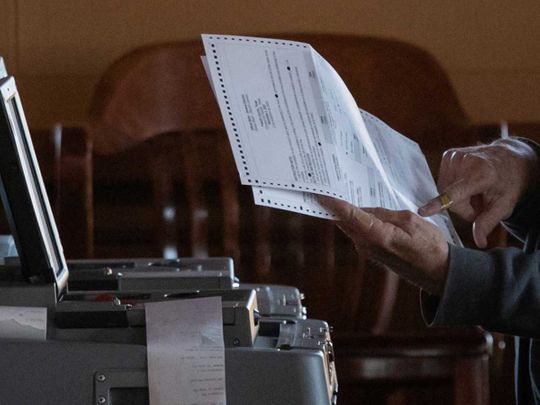
First off, an admission: My father was a postman, so too my grandfather. And twice I have worked in the post office in my university days, sorting parcels and slinging postbags from mail trains to the main sorting office. It is honest work.
But now the very integrity of the postal service is at question in the United States. That’s just a relatively minor issue, however, compared with the integrity of ballots cast by more than 90 million Americans across the US in voting for their new president. With counting still underway — yes, every vote should be counted — President Donald Trump is railing against the inclusion of millions of those mail-in ballots. If he had his way, counting would be stopped right now. He may think he has his way — Thursday night’s 16-minute press briefing from the White House was peppered with untruthful assertions and accusations without an iota of proof — but every vote matters in the US. And means making America wait again.
Waiting and counting are fundamental elements of the election process, a novel concept perhaps for millennials and others used to instant gratification and verbal flagellation on social media platforms. But counting ballots takes time. It always has, likely always will. And mail-in votes delivered through the postal system are an integral part of that process.
In America, the Twenty-Sixth Amendment to the Constitution offers the right to vote on every citizen over the age of 18. It’s universal suffrage, and right now we are all universally suffering waiting for millions of those posted votes to be counted.
The framers of that Constitution left the organisation and administration of elections to each state. From them too came the Electoral College, an arcane system now that back then was favoured to ensure that slave-owning states with their smaller populations would not be overwhelmed and outvoted by more populous states in the North. And back then, it took weeks for the former colonies and new states in the expanding America to tabulate their results and get it back to Washington. Yes, millennials, there was a time before wifi, and things took time.
And in this time of pandemic, postal voting is favoured by those who want their voice to be heard, who don’t want to stand in long lines with others who might be Covid contagious. And those who take the pandemic seriously tend to be Democrats.
The sheer volume of postal voters was a predicament that lawmakers — yes, Republicans and Democrats alike — predicted and made changes to their states’ election laws to assist.
And the mail-in process differs from state to state, commonwealth to commonwealth. Ballots have to put in specially marked envelopes; then some go into another envelope that must be signed and later verified. Anonymity of the initial ballot is essential; A method of verification is also a requirement. And all are put into postage-free envelopes for delivery to states’ counting centres. Pennsylvania, for example, does allow for a couple of extra days to ensure that every mail-in ballot in the postal system that has been postmarked for November 3 gets counted. That’s one reason for the slow pace.
But mail-in ballots need to be opened, flattened, some scanned through verification machines, others into counting machines, others checked by hand. And yes, it all takes time. The more mail-in ballots, the more time. The more time, the more opportunity for bad losers or conspiracy theorists to take to their thumbs and engage in social media feeding frenzies. (I wonder what provision those founding fathers would have made in their wisdom of these platforms now.)
In Pennsylvania, the Republican-controlled legislature refused to change state law to allow county election officials to start processing mail-in ballots until 7am on Election Day. That left local election officials with mountains of absentee ballots to process and count on top of the in-person vote cast on Tuesday.
Overall, Pennsylvania received nearly 2.6 million mail-in ballots, according to the state’s election website. Officials say that’s 10 times the number of absentee ballots it receives in a normal election. In the Democratic stronghold of Philadelphia alone, officials received more than 350,000 absentee ballots that they could not start processing until polls opened Tuesday.
Michigan, which received more than 3.1 million absentee ballots, faced similar restrictions in the run-up to Election Day.
A new state law gave cities with at least 25,000 residents a little more time than usual to process, but not count, mail-in ballots — an extra 10 hours on November 2, the day before the election.
The short window to process mail-in ballots in states such Pennsylvania and Michigan stands in sharp contrast to Florida, where officials began processing ballots weeks before Election Day, allowing them to swiftly report results.
That’s a part of the reason Trump was quickly projected as the winner in Florida.
Did I say it all takes time? Just as it was predicted in the months leading up to last Tuesday’s election day. And during that same time too, President Trump laid the groundwork for calling the postal vote system into question should the counts not go his way.
The irony is that back in August, the Republican candidate cast his own ballot by mail — as he had done in several previous elections too — this time by following Florida State protocols where he has been registered. If there’s one thing we have learnt these past four years, what’s good for Donald J. Trump isn’t necessarily good for everyone else.
But he had no complaints about mail-in voting in 2016, when some 33 million votes were cast through the post. Maybe it’s because those ballots went his way then. Now? Well, let’s just say the result is in the mail.
Mick O’Reilly is the Gulf News Foreign Correspondent based in Europe.







